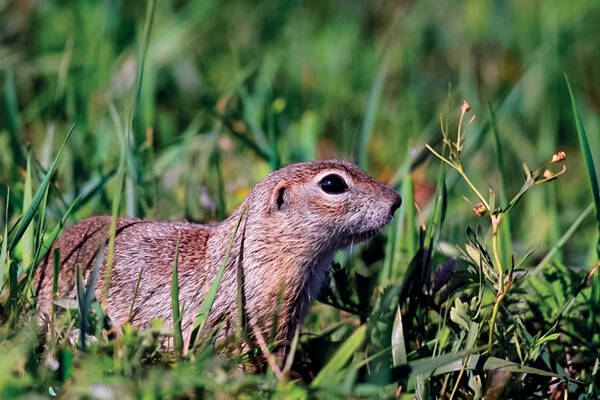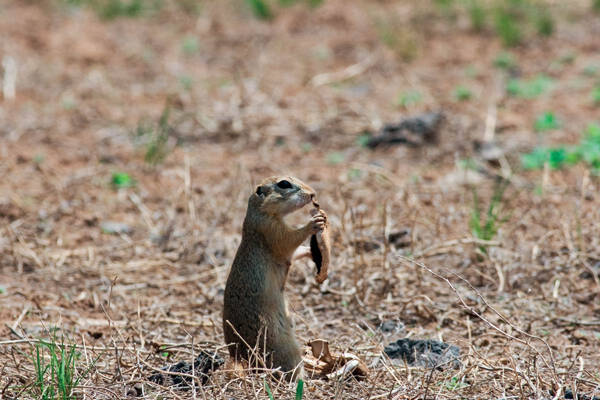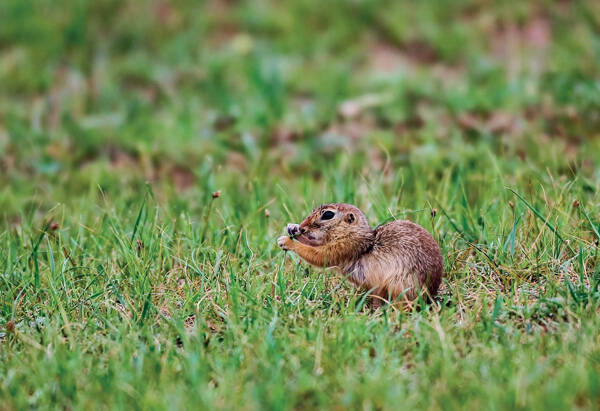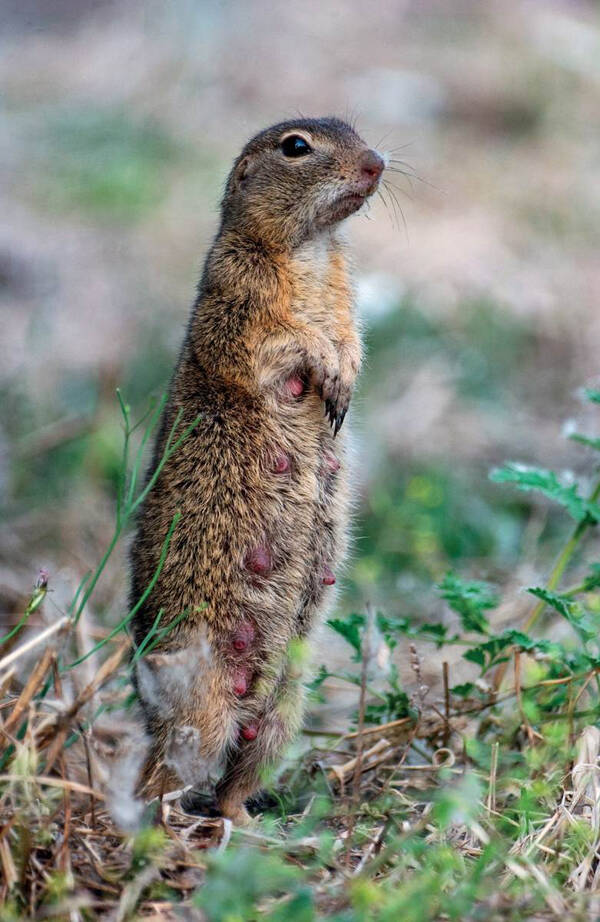Spermophilus dauricus
IUCN
LCBasic Information
Scientific classification
- name:Spermophilus dauricus
- Scientific Name:Spermophilus dauricus,Yellow mouse, Mongolian yellow mouse, prairie yellow mouse, bean mouse, big-eyed thief
- Outline:Rodents
- Family:Rodentia Sciuridae Squirrel
Vital signs
- length:163-230mm
- Weight:154-264g
- lifetime:
Feature
The body is fat, the tail is short, and the back hair is brown. The age of the mouse is determined by body length and weight. The older the mouse is, the longer the incisors are, the darker the color, and the longer the body length is.
Distribution and Habitat
In China, it is distributed in Inner Mongolia, Heilongjiang, Jilin, Liaoning, Shandong, Hebei, central and northern Shanxi, northern Shaanxi and western Gansu. Abroad, it is distributed in Russia and Mongolia.
It lives in arid grasslands or semi-desert environments and has a hibernation habit.
Appearance
The back of the body is sandy yellow with dark brown. The sides, ventral sides and outer sides of the forelimbs are sandy yellow. The center of the upper tail is black and the edges are yellow. There is a white ring around the orbit. The ears are yellow. The skull is not as wide as that of the long-tailed yellow mouse. The snout is shorter. The top of the skull is obviously arched. The eye sockets are large and long. The upper cheek teeth on both sides are obviously arc-shaped.
Details
Daurian ground squirrel is a group of scattered animals, diurnal, one of the representative species of the northern grassland, but occasionally go out of the hole to forage at night. The activity pattern has seasonal changes. The time of ground activity of ground squirrels varies with the season. Usually in mid-April to May, the most frequent daily activities are between 12 and 15 o'clock. In June to August, there are two peaks of activity, 9 to 11 in the morning and 16 to 18 in the afternoon. At the same time, the daily activities of ground squirrels are related to the climate. When the temperature rises to 20-25℃, the ground temperature is 30℃ and it is most active. When the air temperature is higher than 30℃ and the ground temperature is higher than 35℃; when the air temperature and ground temperature are lower than 10℃, the wind speed is greater than 5m/s; the activity is significantly reduced on cloudy and rainy days. Its activity range varies with the change of ecological period. Most mice are strong when they just come out of hibernation, and only a few old and young mice are extremely thin. They are not agile in activity. In addition to resting, they also carry out a small amount of feeding activities. Later, when they enter the mating season, their activity range increases, sometimes running to 300-500m away from the cave.

The activity range of Daurian yellow squirrel is generally about 100m, and its activity distance varies between males and females. The average distance for male adults is 89m, and the average distance for immatures is 98m. The average distance for female adults is 89m, and the average distance for immatures is 99m. The size of the activity distance varies with the seasons. The activity distance of both sexes is the largest in April, and is smaller in May, June and July. The activity distance of juvenile mice is larger in July, smaller in August, and larger in September. The activities in spring are more frequent than in summer, and the mice have extensive contact with each other, especially during the mating period. The number of times they go out of the hole can reach 65 times a day. When the young mice are separated, the average frequency of activities per day is 11 times.
The habitat is basically stable. They settle down after the spring mating period and generally do not migrate. When the density is high, the territoriality is not very obvious.
Daurian ground squirrels mainly feed on plant-based food, mainly on the green parts and seeds of farmland crops and pastures. In autumn, they often prey on insects, frogs and small rodents. After waking up in spring, they feed on the rhizomes of Artemisia. In the grassland, they like to eat Mongolian onion, Salsola, Altai dog wow flower, Artemisia frigida, and milky white flower Astragalus. They do not eat grass plants such as Stipa, Ice grass, and Sheepgrass. In agricultural areas, they mainly eat seedlings of crops, fruits, vegetables, weeds and crop seeds. The average daily fresh grass intake of adult ground squirrels is 160.8g (dry weight 41.57g), and the average daily grass intake of young ground squirrels is 115.77g (dry weight 29.53g).

The Daurian ground squirrel has a keen sense of smell, hearing, and vision, and a strong memory. It remembers the location of the caves within its range of activity very well. It is suspicious and vigilant, looking up while eating. Before leaving the cave, it first listens to the movement outside at the entrance of the cave and then sticks its head out to peek around. When it is confirmed that there is no enemy, it jumps out and stands up to look around, occasionally making calls to call out its peers to come out of the cave to play; once it finds an enemy, it immediately makes a quick call to let its peers take shelter quickly. When disturbed and frightened, they have the habit of blocking holes, blocking holes more than one foot away in a quarter of an hour to protect their lives. Yellow rats are ferocious and often bite each other for mates.
Except for the occasional cohabitation of male and female rats during the mating period, all adult rats live alone. Each rat occupies a group of holes. The holes are divided into roosting holes and temporary holes. Roosting holes can be divided into summer holes and hibernation holes according to different uses. Depending on the season, summer holes can be converted into hibernation holes, and hibernation holes can also be converted into summer holes. Temporary holes are places of refuge for activities outside the cave or foraging. One rat has at least one roosting hole and several or even dozens of temporary holes. The number of temporary holes is often closely related to the soil quality, rat density and the number of natural enemies. Before hibernation, the cave entrance is blocked with soil to create a closed environment to prevent the harm of natural enemies during hibernation and maintain a constant temperature in the cave.

Daurian yellow squirrels have the habit of hibernation. They are active for only 6 months a year and spend most of their time in hibernation. Most of them hibernate from late September to mid-to-late October and come out of hibernation from mid-February to early April of the following year. The time when yellow squirrels come out of hibernation is affected by the geographical location. Generally, they come out of hibernation late in high latitudes and early in low latitudes. For example, in the Guanzhong Plain of Shaanxi and southern Shanxi, yellow rats can be seen emerging from hibernation in mid-February; in the Loess Plateau of northern Shaanxi, in mid-March; in northern Shanxi and Hohhot, Inner Mongolia, in late March; in Xilinhot and Zhengxiangbai Banner, Inner Mongolia, in early April, and at the latest in early May. The order in which yellow rats emerge from hibernation is males first, then females, and first adults, then sub-adults. Females generally emerge about 10 to 20 days after males.
There are two peaks of emergence: the first peak is after the Qingming Festival, which is for male rats; the second peak is before the Guyu Festival, which is for female rats [3]. The emergence of hibernation is closely related to the climate. In spring, the temperature rises day by day, with an average daily rise of 2-5℃, the ground temperature of 4-6℃, and the temperature of about 2℃ at a depth of 1 meter in the ground. Male mice begin to emerge; when the temperature rises to 10℃ and the surface temperature rises to above 12℃, female mice also emerge.
The Daurian yellow squirrel that has just emerged from hibernation will experience a reverse hibernation phenomenon when the weather suddenly turns cold, and will not eat food during the reverse hibernation period. When the temperature drops below 0℃ and the wind speed exceeds 5m/s, the emergence of hibernation will be interrupted. When the temperature rises above 3℃, the emergence of hibernation will occur again. When the temperature reaches 5℃, the number of emergences is relatively stable.
The order of hibernation for Daurian ground squirrels is, first males, then females, and finally the young of the year. After entering the cave, they block the tunnel leading to the nest, curl up in the nest, hold the head and snout tightly with their forelimbs, bend the head and hips to form an oval, and sleep in a side-lying position. Some individuals have a short summer hibernation in addition to hibernation. The life activities of ground squirrels are greatly reduced during hibernation, such as the heart rate drops from 100-350 beats per minute to 5-19 times, and the breathing rate drops from 100-360 times per minute to 10-16 times. When the body temperature is 2.5℃, the heart beats only 5 times per minute.

Daurian yellow squirrels reproduce once a year. After waking up from hibernation in late March, the male testicles drop 100% in mid-April. At this time, males and females chase each other, chirping frequently, looking for mates. Then the female enters the pregnancy period, with a pregnancy rate of more than 92%, and the pregnancy period is about 28 days. There is no difference in the pregnancy rate of female mice in different habitats and different age groups.
The embryo develops slowly in the early stage and quickly in the later stage. By observing the developmental changes of the uterine horns, it is found that the uterine horns of non-pregnant women are generally thick above and below, transparent and milky white; and in the first 2-3 days of pregnancy, there are round and transparent embryos on the uterine horns, with a diameter of about 2mm; 5-6 days of pregnancy, the embryo is 5-6mm; 10 days of pregnancy, the embryo is 10mm; 20 days of pregnancy, the embryo is 20-25mm long, 28 days of pregnancy, the embryo is 32-35mm long, 25mm wide, and weighs 5-6g.
The average number of pups per litter is 5-6, with a maximum of 16-17 and a minimum of 2. According to the statistics of the number of placental spots, the average is 7.19, indicating that the embryos of Daurian yellow squirrels are absorbed during pregnancy, with an average absorption rate of 10.6%. There is no significant difference in the number of pregnancies of Daurian yellow squirrels in different habitats and age groups.
It takes 28 days from mating to giving birth to Daurian yellow squirrels. Female mice begin to give birth in mid-May and end in mid-June, and the birthing period lasts about 25 days. Newborn mice are red in color, have no teeth, no hair, and close their eyes. Ten days after birth, the back of the mice grows hair, and the body length is 65-78mm, and the weight is 12-16g. After 20 days, the mice grow teeth, open their eyes, and are 80-100mm long and weigh 24g. June is the peak period for the mice to suckle. In the second half of the month, the mother mice can be seen leading the mice to move on the ground. 28 days after giving birth, the mice begin to eat independently. At 34-36 days, they dig holes and start to live separately. In July, they live alone in large numbers. It takes more than two months for the yellow rats to mate and separate from the mice. Soon after the separation of the mice, the mother mice also dig new holes to prepare for hibernation.
The normal male-female ratio of the Daurian ground squirrel population is close to 1:1, but the sex ratio between different age groups is different. There are often more males than females in young mice, and the sex ratio of 2-year-old mice is close, while there are more females than males in mice over 3 years old. Young mice account for 58.18% of the population, and mice aged 1-6 account for 18.64%, 12.06%, 5.48%, 3.44%, 1.62%, and 0.58% respectively.
Daurian ground squirrel is a ground-dwelling squirrel, usually living in low hills or plains of typical grasslands dominated by Gramineae, Asteraceae and Leguminosae. It mainly lives in the dry sandy soil areas in open landscape areas and the dry grasslands and adjacent beaches on the gentle slopes of the mountains.
The density of ground squirrels in various habitats changes according to seasonal changes and food conditions. When








